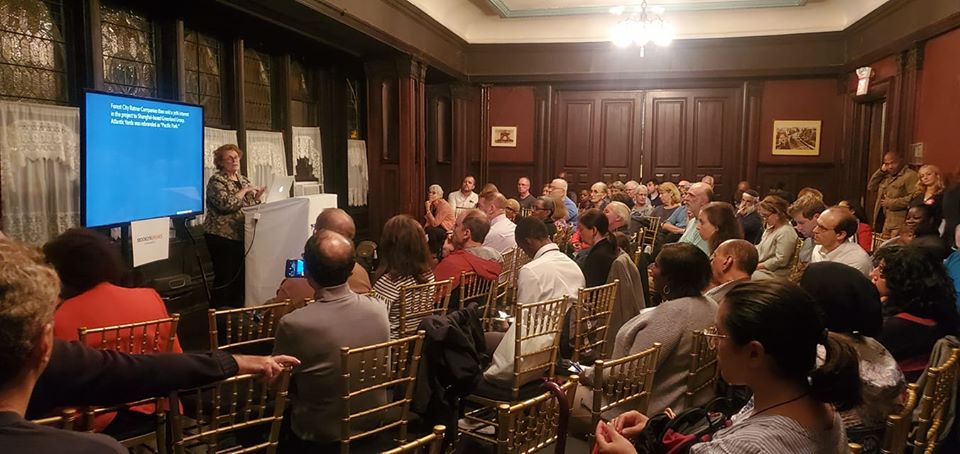After 16 years, it's time for a new plan

On October 3, 2019, more than sixty people gathered at the Montauk Club in Brooklyn at a meeting organized by BrooklynSpeaks to learn about the status of the Atlantic Yards/Pacific Park project, and discuss concerns about the project’s public commitments and environmental impacts.
The meeting began with a presentation led by New York State Assembly members Walter Mosley and Jo Anne Simon, whose districts the Atlantic Yards project overlaps. Announced in 2003, Atlantic Yards promised many public benefits, including an arena, 2,250 affordable apartments, office and hotel space, eight acres of open space, an “Urban Room,” an upgraded LIRR rail yard, a new subway entrance, a health care center, an intergenerational facility, and a public school. The project was originally expected to be completed by 2016. However, in 2009, developer Forest City Ratner renegotiated the completion date to 2035. Under threat of a lawsuit from the BrooklynSpeaks sponsors, the State and Forest City in 2014 agreed to complete all affordable apartments by 2025. Forest City subsequently sold a controlling interest in the project to Shanghai-based Greenland Group, which rebranded it “Pacific Park.”
Today, only the Barclays Center arena, its subway entrance, and the nearby health care center have been completed. Less than 35% of the project’s affordable apartments are finished, and most of the completed units have targeted incomes greater than $130,000 for a family of four. Less than one acre of open space has been provided. The LIRR rail yard is supposed to be complete in 2019; the public school is scheduled to open in 2023. No plans have been announced for the other public amenities.
Michelle de la Uz of the Fifth Avenue Committee and Bernell Grier of IMPACCT Brooklyn expressed concern that the 2025 affordable housing deadline will not be met. Changes to China’s monetary policy may have limited Greenland’s investment in new construction at Atlantic Yards. The company has worked to divest itself of projects in Los Angeles and San Francisco, and recently sold three parcels at Atlantic Yards to other developers. The expiration of the State’s 421a program in 2016 ended the ability of new Atlantic Yards buildings to receive tax abatements without including affordable housing.
Further, future residential buildings at Atlantic Yards must be constructed on a platform yet to be built over two sections of the Vanderbilt rail yards. Each section of the platform is expected to require three years to complete. Although Greenland Forest City Partners announced that it would begin construction of the platform in 2020, it has yet to announce the hiring of a contractor for the work. And Greenland Forest City Partners has refused requests that it release a plan showing how it plans to meet its remaining affordable housing obligation at Atlantic Yards.
North Flatbush Business Improvement District President Regina Cahill described the environmental challenges that have accompanied construction at Atlantic Yards, and have followed the opening of the Barclays Center Arena in 2012. NYPD refuses to utilize parking spaces provided by Atlantic Yards developers per project agreements. Local parking has become extremely constricted, with FDNY and NYPD vehicles overrunning local sidewalks. As a result, alternate side parking is no longer enforced near the arena, resulting in deteriorating street hygiene, including vermin. Illegal parking is rampant during arena events. Problems from concentration of traffic-intensive municipal and private uses at the intersection of Dean Street and Sixth Avenue remain unaddressed by City government.
Gib Veconi of the Prospect Heights Neighborhood Development Council explained that instead of holding developers accountable, Empire State Development has been willing to grant them additional rights, outside the scope of public review. In August 2019, developers who bought leases to Atlantic Yards lots B12 and B13 were able to have NYS ESD approve additional development rights, making the sites more valuable. At the new developers’ request, 105,000 square feet of floor area was added for a fitness center and field house. No additional public benefits were associated with the increase, and ESD’s approval bypassed public review. This is especially troubling given the expectation developers will seek ESD’s approval to transfer building density approved for the arena block across the street to a lot bound by Flatbush Avenue, Pacific Street, Fourth Avenue and Atlantic Avenue known as “Site 5.” The resulting aggregation of density could result in a building of eighty stories or more.
The BrooklynSpeaks’ sponsors, Veconi said, demand that developers be candid about strategy and schedule for completion of the project—including affordable housing commitments—before further approvals are granted. Any increase in private value from project changes must be matched by additional public benefits. The State and the City must take responsibility for the conditions created by the project, and address impacts from construction, arena operations, and municipal services, and a meaningful dialog about further large-scale redevelopment at Brooklyn’s busiest intersection must begin.
The attendees then gathered in groups to propose strategies for moving development forward at Atlantic Yards based upon the following principles:
-
Respect and integrate with surrounding neighborhoods
-
Include a transportation plan that works
-
Create affordable housing that meets the community’s needs
-
Be accountable to the public
Respect and integrate with surrounding neighborhoods
This discussion was led by John Massengale, Chair of the Center for New Urbanism, New York City, and James Ellis, Executive Director of the North Flatbush BID. Participants suggested design strategies to make Atlantic Yards’ large buildings and the spaces around them more inviting, like providing green spaces both around buildings and also inside them, and creating temporary markets for local vendors. Ground floor spaces should be open to visibility from the street. Dean Street should be redesigned as a quiet local street, perhaps including relocation of the firehouse entrance. Technology that could manipulate sunlight to counter the effect of shadows from large buildings should be explored.
Group members saw an opportunity for more active and passive open space in the neighborhood, including basketball courts and playgrounds with space for toddlers. An interest in having the project fulfill its commitment to provide an “urban room” or public atrium was expressed, with some participants suggesting Atlantic Yards also include a municipal or community meeting space.
Providing parking for bicycles at schools in the project buildings was discussed. There were mixed opinions about the amount of off-street garage parking that was optimal for the project. Participants agreed that encouraging more pedestrian use was important, perhaps including interior pathways between buildings.
Include a transportation plan that works
The transportation group was led by Michael Cairl, transportation consultant and member of the Park Slope Civic Council. Parking was a key concern of participants. Legislative solutions like residential permit parking and congestion pricing were proposed. Frustration was expressed about the failure of the NYPD 78th Precinct to utilize the 24 parking spaces provided in the garage at 535 Carlton Avenue.
The group discussed ways to improve transit service in the area. Adding countdown timers to bus stops was suggested, as was creating dedicated bus lanes enforced by automated camera systems. Additional cars should be added to subways serving the Atlantic Avenue/Barclays Center station, and the MTA should study increasing local subway speeds to add more trains as well (more R trains were a particular interest). A new building constructed at Site 5 should include an entrance to the subway from Flatbush Avenue, and the existing sidewalk entrance on Fourth Avenue and Pacific Street should be relocated inside the new building. A new, accessible entrance at Fourth Avenue and Dean Street should also be considered.
Finally, pedestrian safety should be enhanced by further reducing speed limits, adding red light and speed cameras, and introducing traffic-calming features like speed bumps, neckdowns and raised crosswalks.
Create affordable housing that meets the community’s needs
Participants at this session, led by Bernell Grier and Michelle de la Uz, focused on the gap between the housing produced so far at Atlantic Yards versus the needs of current community members at risk of displacement. Dissatisfaction was voiced at the relatively high income levels at which the project’s affordable apartments have been indexed. Some suggested that increased subsidy from HPD and DHCR could play a role in increasing affordability. It was proposed that average affordability for future units must be indexed to 60% of Area Median Income (AMI), with 40% of the units being indexed to 40% AMI. Permanent affordability should also be required. Affordable rents should be indexed to 20% of income, not 30%.
In addition to preference for 50% of the affordable apartments for residents of Brooklyn community boards 2, 3, 6 and 8, it was suggested that at least 10% of the units be reserved for senior citizens. People who have been displaced from the four community districts receiving preference since the project’s approval in 2006 should also receive preference in lotteries.
Be accountable to the public
Regina Cahill and Gib Veconi facilitated this discussion, which also included Assembly member Walter Mosley and City Council member Brad Lander. Participants sought ways to achieve better responsiveness from ESD and developers, perhaps through the Atlantic Yards Community Development Corporation, created as a result of the settlement of a 2014 lawsuit threatened by BrooklynSpeaks against the State and Forest City Ratner. A previous bill in the State legislature to remove ESD from its role in project oversight passed in the Assembly, but did not come to a vote in the State Senate. Assemblyman Mosley suggested a legislative hearing on Atlantic Yards to highlight risks to the project’s affordable housing deadline.
Current shortcomings in environmental oversight and enforcement were discussed. Participants expressed a desire for better cooperation from ESD and the developers in resolving issues relating to Atlantic Yards’ environmental commitments. Reporting such incidents as noise and illegal parking through 311 has not proven to be effective in resolving problems on a timely basis. It was suggested that a reporting solution specific to Atlantic Yards that would allow for the identification of trending issues for resolution by City agencies could be useful. Council Member Lander proposed a hearing by the City Council that could delve into City subsidies, and the City’s role in addressing environmental impacts from the project.
Next steps
The BrooklynSpeaks sponsors plan to incorporate input from meeting participants into a more detailed set of principles for future development at Atlantic Yards. The organizations look forward to continued community engagement toward creating a vision for making Atlantic Yards work for Brooklyn.



